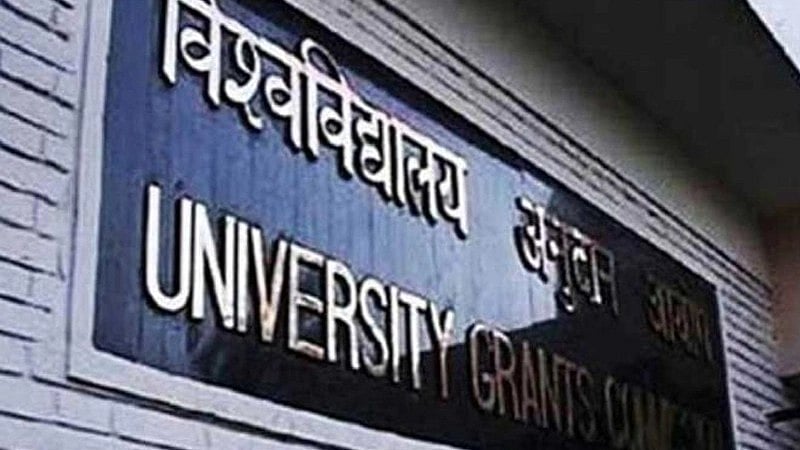
Representative image of the UGC board.
Credit: PTI Photo
The University Grants Commission (UGC) has recently released two new draft guidelines seeking public feedback. The first relates to evaluating higher education institutions (HEIs) based on the implementation of the National Education Policy (NEP) 2020.
The evaluation process comprises two steps: eligibility qualifiers and quantifier parameters. The eligibility qualifiers involve basic institutional information and whether the institution has registered for the Academic Bank of Credit. However, this poses a challenge for autonomous colleges and universities in states yet to implement NEP.
The second step, quantifier parameters, assesses universities, autonomous colleges, and affiliated colleges across 49 criteria. Not all of these apply to autonomous and affiliated colleges. For example, the very first parameter mandates that at least 75% of teaching staff be permanent faculty. This target is far from realistic.
In most universities of Karnataka, not even 50% of teaching staff are permanent, and in the autonomous colleges, more than 80% are appointed by the management, where the attrition rates are very high.
In Karnataka’s 32 public universities, of the 4,709 sanctioned teaching posts, only 1,986 are permanently filled posts, and 2,723 posts are vacant. At Bangalore University, 234 teaching posts are vacant, and at Bengaluru City University, 150 posts are vacant. If such is the situation in a progressive state like Karnataka, what would it be elsewhere? The UGC must consider these ground realities when setting benchmarks.
Another parameter requires appointing Professors of Practice—professionals from industries without formal teaching experience. However, understanding classroom dynamics is no easy task for non-academics. They are likely to demand higher remunerations, and finding such resources in semi-urban or rural areas may be impractical.
HEIs are also required to enrol a minimum of 3,000 students. This is unrealistic, given that nearly two-thirds of colleges in India have fewer than 500 students. Institutions failing to meet this threshold risk losing UGC benefits and may be forced to shut down.
Furthermore, the new guidelines favour universities and autonomous colleges implementing four-year degree programmes; but affiliated colleges choose not to implement the four-year programme. Does that mean they can continue with the three-year degree programme?
HEIs in India currently cater to a system of 3+2 years of higher education, and very few institutions and universities offer research programmes. Of the 1,222 autonomous colleges in India, over 75% lack infrastructure to offer four-year degree programmes.
A four-year programme also places an economic burden on students, especially those from low- and middle-income families. It caters to less than 1% of students who seek admission abroad, where a four-year degree is a prerequisite.
The multiple entry and exit option under the NEP adds further uncertainty. It complicates course planning, increases the administrative workload of staff members, and risks students dropping out for financial reasons to obtain a diploma or certificate mid-way.
As per the 2024 All India Survey of Higher Education (AISHE) report, India has 58,000 HEIs but only 46,000 international students—a ratio of less than one student per institution. With UGC allotting marks for attracting international students, most HEIs will lose out. Similarly, the Common University Entrance Test undermines the autonomy of the HEIs in managing their own admission processes and admitting students of their choice.
The draft guidelines also overload students. Within a 36-hour campus week, students must balance core subjects, allied subjects, languages, open electives, physical fitness, sports, yoga, artificial intelligence, digital literacy, psychological and emotional well-being, fostering social responsibility, community engagement, life skills, local arts, human values, professional ethics, online courses, Indian knowledge systems, intellectual property rights, and more. This compromises academic specialisation, producing graduates with superficial knowledge across disciplines.
HEIs failing to comply with these guidelines will be ineligible for UGC schemes. Moreover, UGC stopped granting funds to colleges in 2018.
The second notification relates to the appointment of teachers and vice chancellors (VCs). It allows individuals with 10 years of senior-level experience in public administration, public policy, or industry—without an academic background—to apply for VC positions.
The onus of appointing the VCs is now entirely on the chancellor or governor of the state, sidelining state governments and potentially alienating local candidates familiar with the region’s culture and needs.
Professors need not be the VC candidates anymore; any individual with 10 years of senior-level experience in public administration, public policy, or industry can apply. This takes away the charm of the rigour and understanding of academics in higher education.
Education was initially a state subject, and now it is in the concurrent list. However, recent developments suggest a shift toward centralising education under the Union list, eroding states’ control over this critical sector.
(The writer is the principal of St Joseph’s Evening College (autonomous)
and an associate professor at St Joseph’s University)